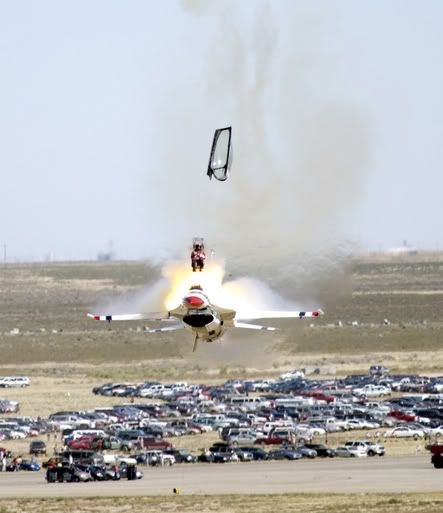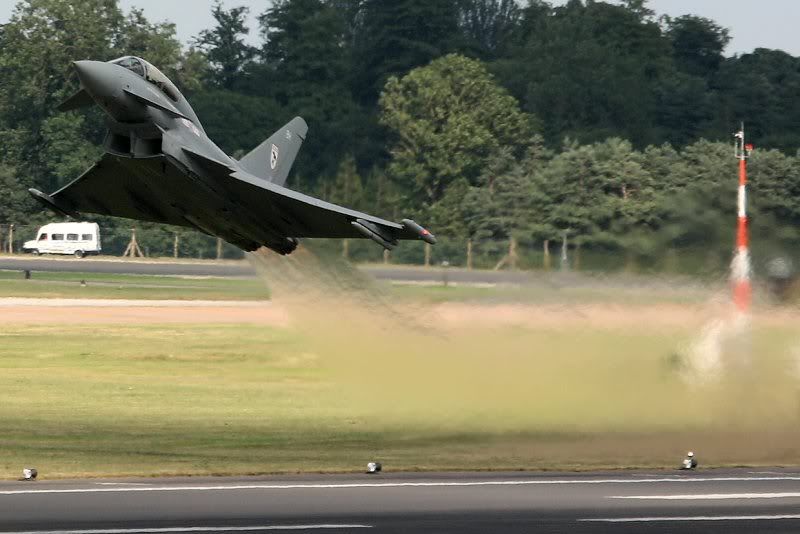|
|
Post by corsair67 on Nov 6, 2005 17:30:14 GMT 12
How's this for a great shot of a live ejection?  MOUNTAIN HOME AIR FORCE BASE, Idaho -- Capt. Christopher Stricklin ejects from the USAF Thunderbirds number six aircraft less than a second before it impacted the ground at an air show at Mountain Home Air Force Base, Idaho, Sept. 14, 2003. Stricklin, who was not injured, ejected after both guiding the jet away from the crowd of more than 60,000 people and ensuring he couldn't save the aircraft. This was only the second crash since the Air Force began using F-16 Falcons for its demonstration team in 1982. The ACES II ejection seat performed flawlessly. (U.S. Air Force photo by Staff Sgt. Bennie J. Davis III)  You can find a hi-res version of this picture on the USAF website at - www.af.mil/shared/media/photodb/photos/040130-F-0000C-002.jpg |
|
|
|
Post by Dave Homewood on Nov 6, 2005 18:53:41 GMT 12
Cor!!
Thanks for that mate!
|
|
|
|
Post by Bruce on Nov 6, 2005 19:41:22 GMT 12
Followed shortly by the photographer running like hell?!!  |
|
|
|
Post by DragonflyDH90 on Nov 6, 2005 19:57:18 GMT 12
He now flies a desk, it was reported that he may have miss set his altimeter and therefore miss read his height the split S then began to turn pear shaped on the pull out. It is a rather dangerous maneuvre at low level and has claimed numerous lives. The low level loop has similar problems, some will remember a certain Chipmunk in NZ, as well as a Russian Mig 29 (I think) www.aeronautics.ru/nws001/awst008.htm which collected the ground caught fire with the pilot attempting to climb away, shortly followed by a rapid ejection with the aircraft exploding on impact. Most recently the Euro Fighter (Typhoon) nearly wiped itself out doing a similar pullout at the RIAT airshow.  It amazes me that people still do this maneuvre at shows....... |
|
|
|
Post by corsair67 on Nov 7, 2005 8:38:14 GMT 12
There is some excellent video taken from the cockpit of the pilot banging out of this F-16, but I can't exactly remember which website it was on! I have a copy of the video on my computer: can video be posted directly on this site?
I have an A3 copy of this picture on my office wall, and heaps of people (including many whom have no interest in aviation) have commented on what a great photo it is.
|
|
|
|
Post by Dave Homewood on Nov 7, 2005 11:17:08 GMT 12
|
|
|
|
Post by corsair67 on Jan 23, 2006 20:04:38 GMT 12
Found the accident report on the USAF website. It's quite long, but interesting nevertheless.
AIRCRAFT ACClDENT INVESTIGATION, F-16C, S/N 87-0327
57 FW / USAF ADS, NELLIS AIR FORCE BASE, NEVADA
14 SEP 2003
On 14 September 2003, at 1516 hours local time, F-16C S/N 87-0327 crashed between the runway and the control tower at Mountain Home Air Force Base, Idaho, while performing an aerial demonstration. The mishap pilot (MP), "Thunderbird 6," successfully ejected prior to the impact and sustained only minor injuries. The mishap aircraft (MA) was destroyed with the loss valued at $20,415,911.93.
The aircraft and the pilot were assigned to the USAF Aerial Demonstration Squadron (ADS), 57th Fighter Wing, Nellis Air Force Base, Nevada, and were operating as number 6 of the USAF Thunderbirds. There were no civilian or military casualties. No property, other than the MA, was damaged. Environmental impact was limited to soil contaminated by JP-8 where the fuselage came to rest, thus the costs for the clean up
of the mishap were nominal.
The crash occurred 25 seconds into Thunderbird 6's flight. The pilot was performing the "Maximum Climb and Split S on takeoff maneuver when the mishap occurred. Mountain Home airfield elevation is 2,996 feet above Mean Sea Level (MSL). The Thunderbirds used a 3000 foot altimeter setting for the
demonstration.
The mishap pilot took off at the proper time, 25 seconds after Thunderbird 5. The MP rotated at 200 knots, retracted the landing gear, and performed the maximum climb. The MP climbed at 55 degrees. At 4,670 feet MSL (1,670 feet above ground level (AGL)), the pilot initiated an unloaded roll to inverted.
The target altitude to initiate the-roll was 5500 feet MSL, (2500 feet AGL). The mishap pilot's planned apex (the highest point of the maneuver) was 6500 feet MSL (3500 feet AGL). The mishap pilot's actual apex altitude was 5760 feet MSL (2760 feet AGL). The MP called "three five" (meaning 3500 feet AGL)
after reading 5500 feet on the heads up display (HUD) altimeter. The safety observer upon hearing "three five" allowed the maneuver to continue. The MP pulled back to complete the Split S. Upon reaching 90 degrees nose low, the MP recognized that "something was wrong." He had in fact put the aircraft in a position from which it could not be recovered. The MP commanded maximum back stick pressure in an attempt to recover and rolled slightly left to ensure the aircraft would impact away from the crowd should he have to eject. Upon realizing that he could not avoid ground impact, the MP ejected from the aircraft at 3140 feet MSL (140 feet AGL), 0.8 seconds prior to aircraft impact. The mishap pilot's ejection was successful and the aircraft impacted the ground on the opposite side of the show line from the crowd.
There is clear and convincing evidence that pilot error caused the mishap. The pilot misinterpreted his altitude above the ground causing him to roll and apex approximately 1000 feet below the target altitudes.
He mistakenly interpreted 4500 feet MSL as the planned 2500 feet AGL roll altitude and 5500 feet MSL as the target 3500 foot AGL apex altitude. Thus, upon reading 5500 feet MSL on the altimeter, he called "three five" and initiated a Split S that the aircraft was incapable of successfully completing prior to
ground impact.
Three factors substantially contributed to creating the prospect for such a critical error. The requirement for demonstration pilots to real time convert MSL to AGL numbers, a maneuver with a limited margin of error, and a preconscious level of awareness created a situation more susceptible to pilot error.
(Under 10 U.S.C. 2254(d), any opinion of the accident investigators as to the cause of, or the factors contributing to, the accident set forth in the accident investigation report may not be considered as evidence in any civil or criminal proceeding arising from an aircraft accident, nor may such information be considered an admission of liability by the United States or by any person referred to in thoe conclusions or statement.)
|
|



